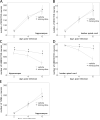Neuroprotective interventions targeting detrimental host immune responses protect mice from fatal alphavirus encephalitis
- PMID: 17549013
- PMCID: PMC3143496
- DOI: 10.1097/01.jnen.0000263867.46070.e2
Neuroprotective interventions targeting detrimental host immune responses protect mice from fatal alphavirus encephalitis
Abstract
Systemic treatment with the tetracycline derivative, minocycline, attenuates neurologic deficits in animal models of amyotrophic lateral sclerosis, hypoxic-ischemic brain injury, and multiple sclerosis. Inhibition of microglial activation within the CNS is 1 mechanism proposed to underlie the beneficial effects of the drug in these systems. Given the widening scope of acute viral encephalitis caused by mosquito-borne pathogens, we investigated the therapeutic effects of minocycline in a murine model of fatal alphavirus encephalomyelitis in which widespread microglial activation is known to occur. We found that minocycline conferred significant protection against both paralysis and death, even when started after viral challenge and despite having no effect on CNS virus replication or spread. Further studies demonstrated that minocycline inhibited early virus-induced microglial activation and that diminished CNS production of the inflammatory mediator, interleukin (IL)-1beta, contributed to its protective effect. Therapeutic blockade of IL-1 receptors also conferred significant protection in our model, validating the importance of the IL-1 pathway in disease pathogenesis. We propose that interventions targeting detrimental host immune responses arising from activated microglia may be of benefit in humans with acute viral encephalitis caused by related mosquito-borne pathogens. Such treatments could conceivably act through neuroprotective rather than antiviral mechanisms to generate these clinical effects.
Figures







Similar articles
-
Protective Effects of Glutamine Antagonist 6-Diazo-5-Oxo-l-Norleucine in Mice with Alphavirus Encephalomyelitis.J Virol. 2016 Sep 29;90(20):9251-62. doi: 10.1128/JVI.01045-16. Print 2016 Oct 15. J Virol. 2016. PMID: 27489275 Free PMC article.
-
The opioid receptor antagonist, naloxone, protects spinal motor neurons in a murine model of alphavirus encephalomyelitis.Exp Neurol. 2007 Jun;205(2):461-70. doi: 10.1016/j.expneurol.2007.03.013. Epub 2007 Mar 23. Exp Neurol. 2007. PMID: 17459376 Free PMC article.
-
Neuroprotective and anti-human immunodeficiency virus activity of minocycline.JAMA. 2005 Apr 27;293(16):2003-11. doi: 10.1001/jama.293.16.2003. JAMA. 2005. PMID: 15855434
-
The role of antibody in recovery from alphavirus encephalitis.Immunol Rev. 1997 Oct;159:155-61. doi: 10.1111/j.1600-065x.1997.tb01013.x. Immunol Rev. 1997. PMID: 9416509 Review.
-
Alphavirus Encephalomyelitis: Mechanisms and Approaches to Prevention of Neuronal Damage.Neurotherapeutics. 2016 Jul;13(3):455-60. doi: 10.1007/s13311-016-0434-6. Neurotherapeutics. 2016. PMID: 27114366 Free PMC article. Review.
Cited by
-
HSP60 critically regulates endogenous IL-1β production in activated microglia by stimulating NLRP3 inflammasome pathway.J Neuroinflammation. 2018 Jun 9;15(1):177. doi: 10.1186/s12974-018-1214-5. J Neuroinflammation. 2018. PMID: 29885667 Free PMC article.
-
Minocycline prevents primary duck neurons from duck Tembusu virus-induced death.J Vet Med Sci. 2021 Apr 24;83(4):734-741. doi: 10.1292/jvms.20-0735. Epub 2021 Mar 15. J Vet Med Sci. 2021. PMID: 33716232 Free PMC article.
-
Manipulation of host factors optimizes the pathogenesis of western equine encephalitis virus infections in mice for antiviral drug development.J Neurovirol. 2015 Feb;21(1):43-55. doi: 10.1007/s13365-014-0297-8. Epub 2014 Nov 1. J Neurovirol. 2015. PMID: 25361697 Free PMC article.
-
Tetracycline and viruses: a possible treatment for COVID-19?Arch Virol. 2021 Jan;166(1):1-7. doi: 10.1007/s00705-020-04860-8. Epub 2020 Nov 2. Arch Virol. 2021. PMID: 33136210 Free PMC article. Review.
-
Aseptic meningitis and viral myelitis.Neurol Clin. 2008 Aug;26(3):635-55, vii-viii. doi: 10.1016/j.ncl.2008.03.003. Neurol Clin. 2008. PMID: 18657719 Free PMC article. Review.
References
-
- Jackson AC, Moench TR, Trapp BD, et al. Basis of neurovirulence in Sindbis virus encephalomyelitis of mice. Lab Invest. 1988;58:503–509. - PubMed
-
- Jackson AC, Moench TR, Griffin DE, et al. The pathogenesis of spinal cord involvement in the encephalomyelitis of mice caused by neuroadapted Sindbis virus infection. Lab Invest. 1987;56:418–423. - PubMed
-
- Kelley TW, Prayson RA, Isada CM. Spinal cord disease in West Nile Virus infection. N Engl J Med. 2003;348:564–566. - PubMed
Publication types
MeSH terms
Substances
Grants and funding
LinkOut - more resources
Full Text Sources
Medical

